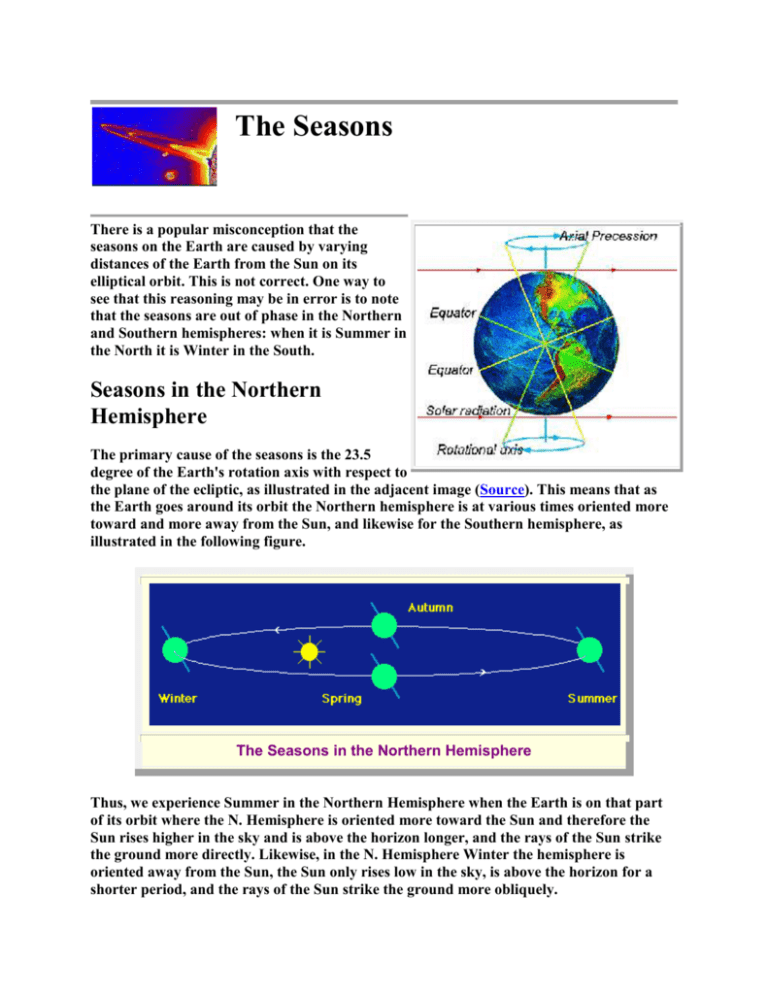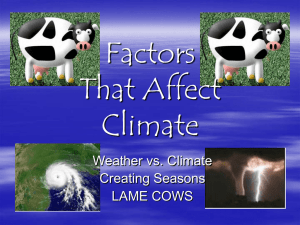The Seasons - IHMC Public Cmaps (3)
advertisement

The Seasons There is a popular misconception that the seasons on the Earth are caused by varying distances of the Earth from the Sun on its elliptical orbit. This is not correct. One way to see that this reasoning may be in error is to note that the seasons are out of phase in the Northern and Southern hemispheres: when it is Summer in the North it is Winter in the South. Seasons in the Northern Hemisphere The primary cause of the seasons is the 23.5 degree of the Earth's rotation axis with respect to the plane of the ecliptic, as illustrated in the adjacent image (Source). This means that as the Earth goes around its orbit the Northern hemisphere is at various times oriented more toward and more away from the Sun, and likewise for the Southern hemisphere, as illustrated in the following figure. The Seasons in the Northern Hemisphere Thus, we experience Summer in the Northern Hemisphere when the Earth is on that part of its orbit where the N. Hemisphere is oriented more toward the Sun and therefore the Sun rises higher in the sky and is above the horizon longer, and the rays of the Sun strike the ground more directly. Likewise, in the N. Hemisphere Winter the hemisphere is oriented away from the Sun, the Sun only rises low in the sky, is above the horizon for a shorter period, and the rays of the Sun strike the ground more obliquely. In fact, as the diagram indicates, the Earth is actually closer to the Sun in the N. Hemisphere Winter than in the Summer (as usual, we greatly exaggerate the eccentricity of the elliptical orbit in this diagram). The Earth is at its closest approach to the Sun (perihelion) on about January 4 of each year, which is the dead of the N. Hemisphere Winter. (The time for perihelion, aphelion, and the solstices for any year 1992-2000 is available in this compilation.) For a more extensive introduction to how variations in the amount of solar energy reaching the Earth's surface influence climate, see this discussion of solar databases for global change models. Another Fallacy to Avoid Incidentally, one should be precise in terminology. A common student answer for the cause of the seasons is that "the Earth tips toward the Sun in the Summer, . . .". This conveys the impression that the Earth moves around its orbit and at certain times of the year the rotation axis suddenly tips one way or another and thus we have seasons. As the preceding diagram makes clear, the rotation axis of the Earth remains pointed in the same direction (except for small effects from precession) as it moves around its orbit. It is the relative location of the Sun with respect to this constant tilt angle that causes the seasons, not some elaborate square dance of the Earth bowing to its partner as it moves around its orbit! Southern Hemisphere Seasons As is clear from the preceding diagram, the seasons in the Southern Hemisphere are determined from the same reasoning, except that they are out of phase with the N. Hemisphere seasons because when the N. Hemisphere is oriented toward the Sun the S. Hemisphere is oriented away, and vice versa: The Seasons in the Southern Hemisphere The Lag of the Seasons The preceding reasoning for the causes of the seasons is idealized. In reality, we know that the seasons "lag": for example, the hottest temperatures in the Summer usually occur a month or so after the time of maximum insolation (the time when maximum solar energy is deposited during a day at a point on the surface of the Earth). This is because the Earth and its atmosphere store heat (the oceans are particularly effective heat sinks). Thus, a detailed description of the seasons is quite complicated since it must take into account complex local variations in the storage of solar energy. However, the basic reason for the seasons is simple, as described above. Simulating the Apparent Motion of the Sun One can use the Starry Night program for Windows and the Macintosh to simulate the appearance of the sky at any time, from any chosen vantage point in the Solar System. Thus, by choosing different points on the surface of the Earth at different times of the year, this program can be used to show the motion of the Sun through the sky and illustrate clearly the preceding points about the causes for the seasons. Here is an extreme example: In the N. Hemisphere Summer at latitudes above the Arctic Circle (23.5 degrees away from the N. Pole) the Sun stays above the horizon for the entire day (midnight sun). The adjacent image illustrates the midnight sun. This GOES-8 weather satellite visible light image is taken from a vantage point high above the western hemisphere, with the North at the top. Even though the local time for the longitude line under the satellite is near midnight, the Northernmost portion of the globe is illuminated by sunlight (the lighted portion actually extends below the arctic circle in this image because of sunlight scattering in the atmosphere). This simulation of the midnight sun was made using the Starry Night program with a "fisheye lens" perspective to show a wide (180 degree) region of the sky from a vantage point at the North Pole on July 4, 1996. As the movie illustrates, the Sun moves more or less parallel to the horizon and never goes below it during the course of a day at these latitudes at this time of the year. Conversely, in the N. Hemisphere Winter the Sun never comes above the horizon for the entire day at this latitude. This is an extreme example of the difference in insolation in Winter and Summer for the N. Hemisphere that is responsible for the seasons. The exact time of sunrise and sunset (and similar data for moonrise and moonset) may be calculated for any date and 22,000 named cities in the United States, or by specifying the latitude and longitude of any location worldwide, using this program. For locations in the United States, a table of corresponding information for an entire year (past, present, or future) may be calculated using this program









